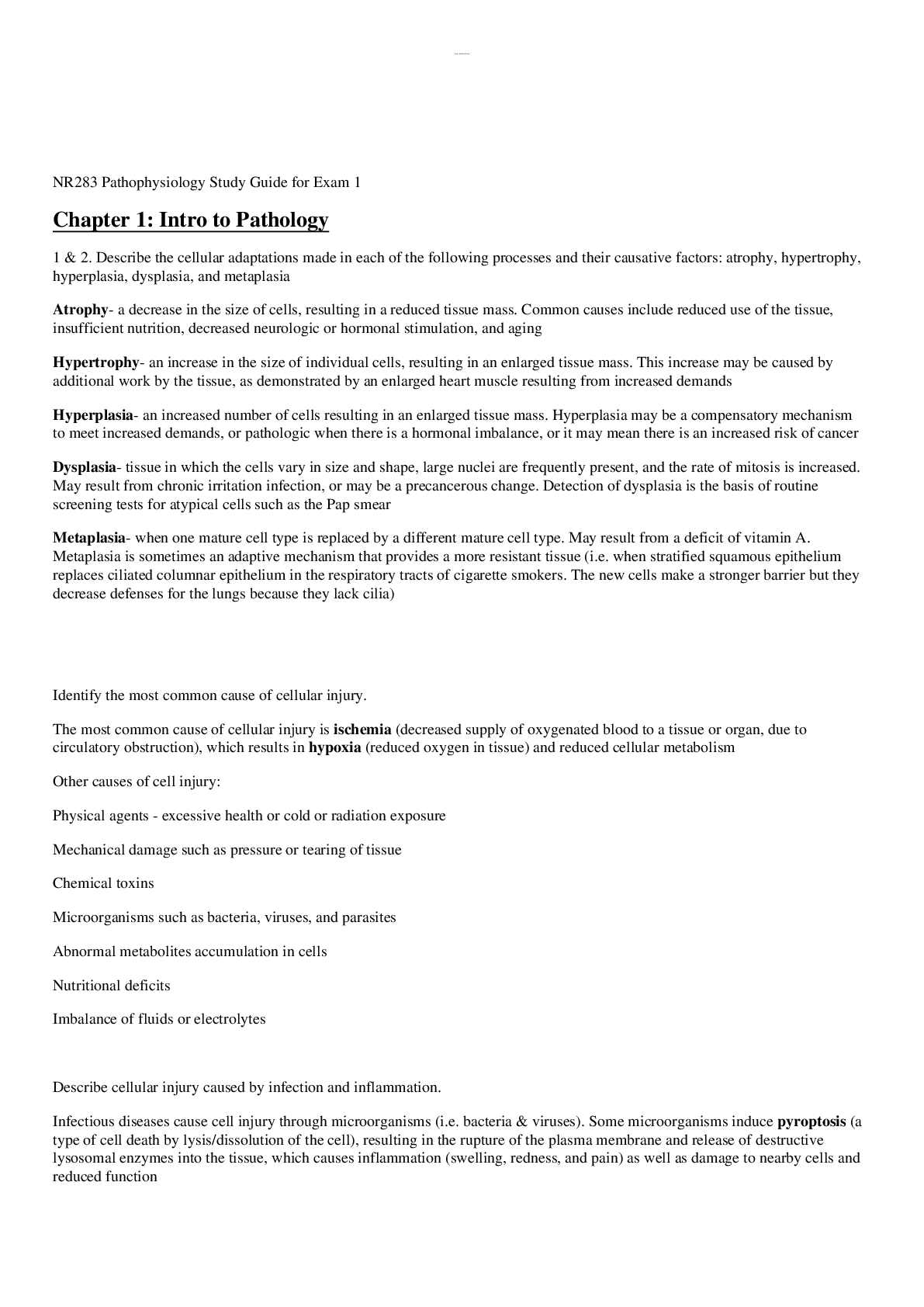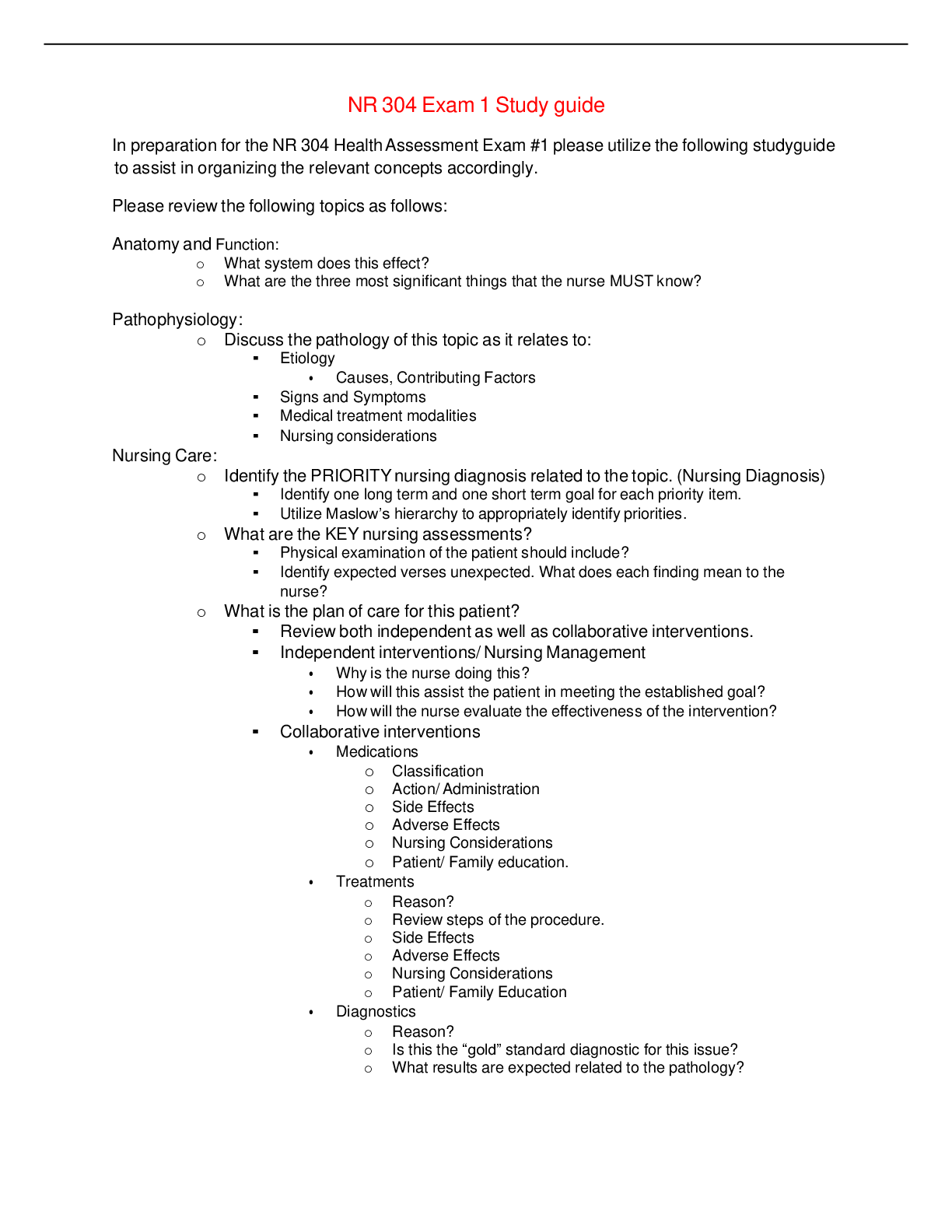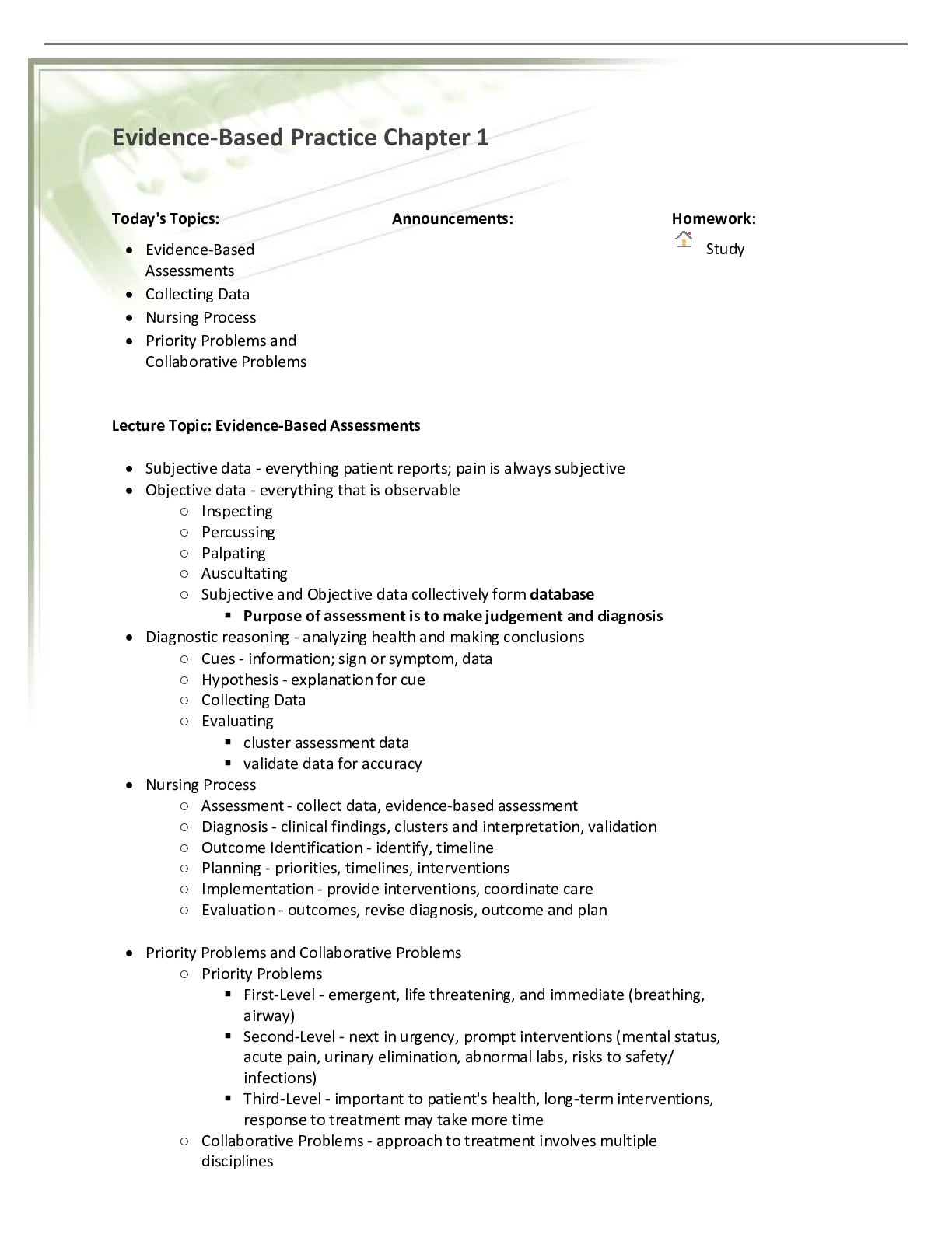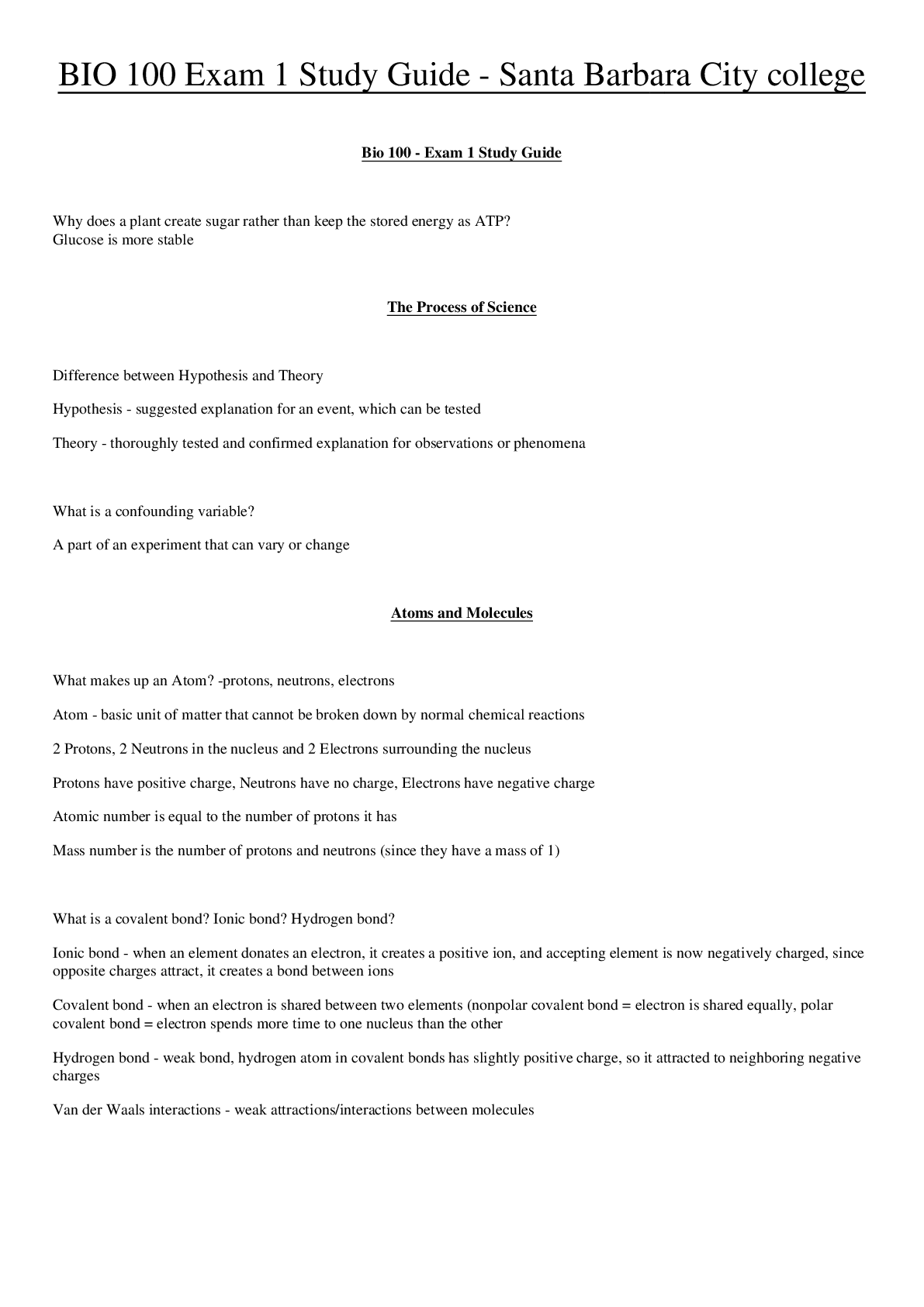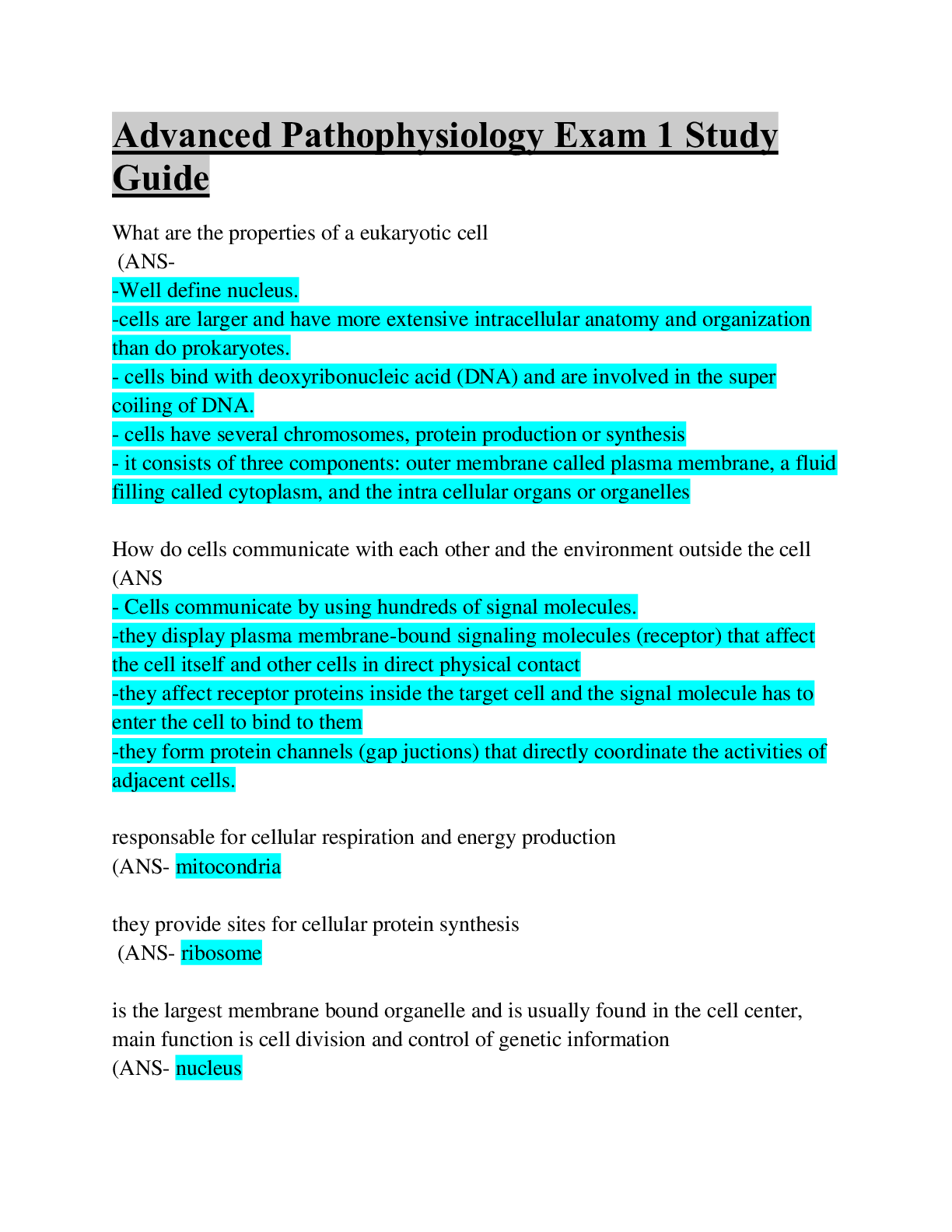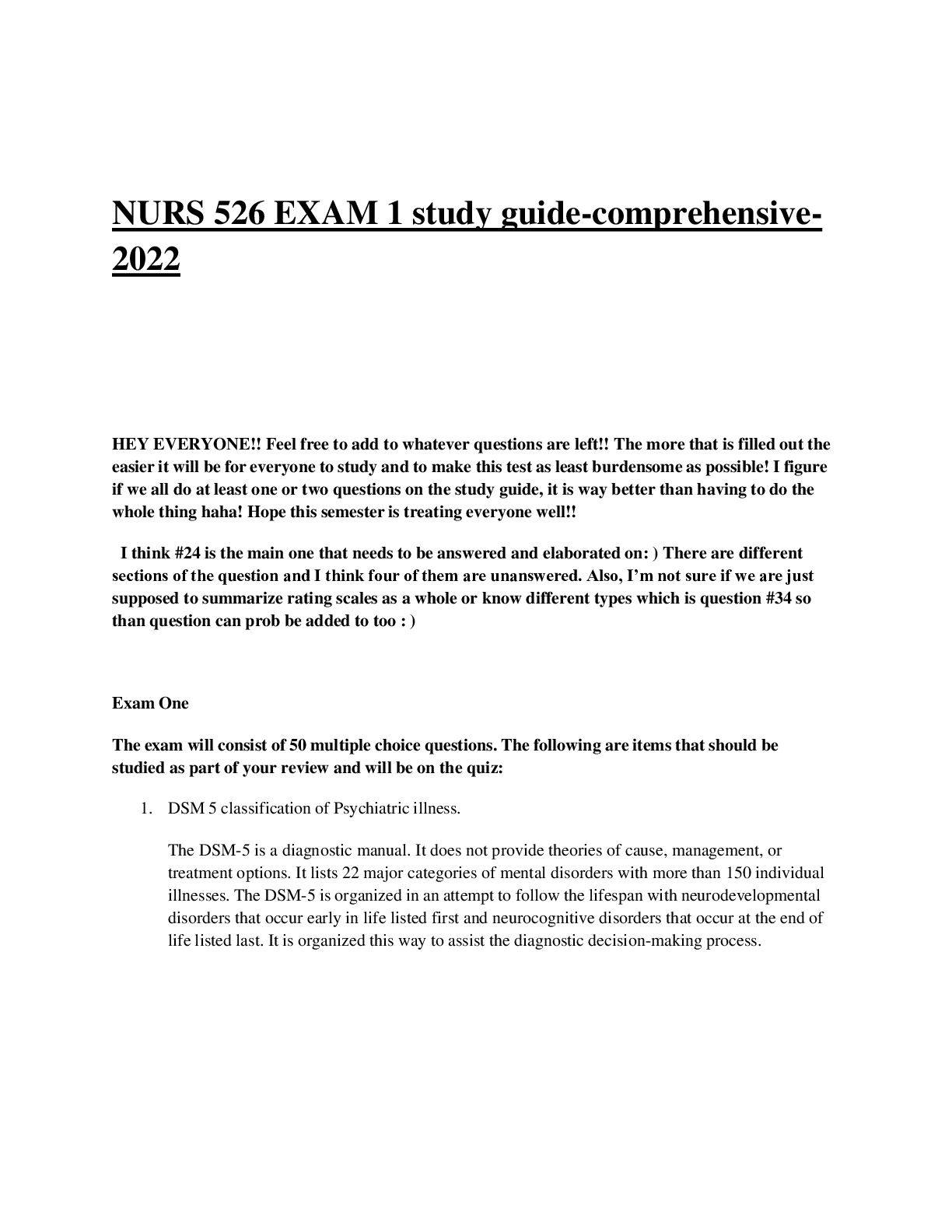*NURSING > STUDY GUIDE > NUR 375/OB Exam 1 Study guide Chapter 1 Latest updated 2021/2022,100% CORRECT (All)
NUR 375/OB Exam 1 Study guide Chapter 1 Latest updated 2021/2022,100% CORRECT
Document Content and Description Below
NUR 375/OB Exam 1 Study guide Chapter 1 Latest updated 2021/2022 Maternity nursing encompasses: preconception, pregnancy, childbirth and first 6 weeks of child’s life Health disparities – r... efer to differences in the health status of different groups of people. Some groups of people have higher rates of certain diseases and more deaths and suffering from them, compared to others (linked to: biologic factors, environment, socioeconomic factors, health behaviors) Morbidity: unhealthy state of an individual within a population Mortality: # of people who died within a population Healthy people 2020: Science based assessments for improving health of all Americans 4 goals: - attaining high quality, longer lives free from preventable disease, disability, injury and premature death - achieving health equity, eliminating disparities, improving health of all groups - creating social and physical environments that promote good health for all - promoting quality of life, healthy development and healthy behaviors across all life stages Contemporary issues: Integrative health care: Holistic heath care, complementary and alternative therapies Interprofessional education: Collaborative learning, interprofessional communication, SBAR Failure to communicate is a major cause of errors To the patient, to peers, to health care provider, etc. Problems with health care delivery system Structure of system, don’t take short cuts, reduce med errors (3rd leading cause of death in US) High cost of healthcare Health literacy Limited access to care Inability to pay, lack of transportation, childcare, insurance Trends in fertility: Low birth weight and preterm - less than 2500 grams or 5lbs 8 oz - preterm is before 37 weeks gestation Maternal mortality - cardiovascular disease, non-cardiovascular, infection, unsafe abortion - age is strongly related, less than 20 and more than 35 Maternal morbidity- (results in high risk pregnancy) - Obesity - risk factors pregnancy induced hypertension (PIH) & diabetes Decreased fertility, congenital anomalies, miscarriage and fetal death Regional services – Availability of services for high risk prenatal patients Ambulatory care Basic care – OB, family physicians, midwifes - routine prenatal care Specialty care - OB’s for fetal diagnostic testing and managing of complications Subspecialty care – maternal fetal medicine specialized and reproductive geneticists - includes genetic testing, advanced fetal therapy, severe maternal / fetal complications Evidence based practice: providing care based on evidence gained through research and clinical trials - AWHONN – association of women’s health, OB and neonatal nurses - WHO – world health organization - QSEN – quality and education for nurses Prevention of errors: Don’t use abbreviations Consult agency policies if unsure on how to perform a procedure Ethical issues: Technology, scientific advances, informed consent Reproductive technology: Fetal surgery in uterine, therapeutic insemination, stem cell research, genetic engineering, surrogate childbearing, treatment of VLBW (low birth weight babies) Chapter 3: Barriers to entering health care system: Finances, cultural, sexual orientation (gender issues) Substance abuse: Marijuana – crosses placenta and reduces oxygen to fetus Cocaine – causes vasoconstriction (fetus wont have oxygen supply they need), preterm labor, small for gestational age, increases risk miscarriage, still birth Opiates – women have 6 time higher risk for issues Methamphetamine - irregular heart beat, hypertension, preterm birth, intrauterine growth, smaller head circumference PCP – neurobehavioral effects on neonate Alcohol – low birth weight, behavioral problems, intellectual disability Fetal alcohol syndrome is the only birth defect that can be prevented Cigarette – vasoconstriction, decrease placental perfusion and is one cause of low birth weight Caffeine – increase risk of miscarriage Risk factors: Low folate = neural tube defects Obesity – BMI of mother between 30-34.5 Eating disorders – anorexia and bulimia Lack of exercise Extreme stress Mental health issues – depression, anxiety, sleep disorders Physical – endometriosis, uterine fibroids, female genital mutilation, risky sex practices Violence against women – Intimate partner violence – most common! – may get worse when pregnant Physical or emotional abuse, sexual assault, isolation, controlling of women’s life Never take a pt history with anyone else in the room so they can be honest, look unexplainable or untreated injuries, injuries that don’t mask description given Female anatomy – ◦ Uterus-a muscular pear shaped organ that is responsible for cyclic menstruation ◦ Cervix- made up of mostly fibrous connective tissues and elastic tissue making it possible to stretch during vaginal childbirth ◦ Bony pelvis – protects growing fetus during pregnancy, holds support structures together, ischial spine is he most narrow part of pelvis is baby is too big it wont fit through because of this Breast – Structure ◦ Mammary gland composed of a number of lobes, divided into lobules ◦ Physiologic alterations in breast size reach minimal level about 5 to 7 days after menstruation stops- best time to complete breast exam Menstruation Day 1-5: menstruation cycle, menses Day 5-14: proliferative phase (follicular phase) – INCREASE IN ESTROGEN Ovulation on 14th day: LH and FSH SURGE Day 14 – 25: secretory phase (luteal phase) INCREASE IN PROGESTERONE, if ovum is fertilized will happen in this phase!!!! Day 25-28: ischemic phase, DECREASE IN ESTROGEN AND PROGESTERONE • ACHES Pill Warning Signs • ABDOMINAL PAIN • • Blood clot in the pelvis or liver [mesenteric or pelvic vein thrombosis] • Vomiting • Cramping • Weakness • CHEST PAIN • • Blood clot in the lung or heart vessels [pulmonary embolism or myocardial infarction] • Heart attack, angina • Chest or heart pain, left arm and shoulder pain • Coughing and shortness of breath • HEADACHES • • Stroke • Blurred vision, spots, zigzag lines, weakness, difficulty speaking • Sudden intellectual impairment • EYE PROBLEMS • • Stroke or retinal vein thrombosis • Complete or partial loss of vision • SEVERE LEG PAIN • • Inflammation and blood clots of a leg in the leg [thrombophlebitis] • Swelling, heat or redness, tenderness in leg • You should also return to the office if you develop severe mood swings or depression, become jaundiced (yellow-colored skin), miss 2 periods or have signs of pregnancy. Progesterone: - helps maintain pregnancy Prostaglandins – - oxygenated fatty acid classified as a hormone, produced in most organs of body (including uterus), menstrual blood is potent PG source - Effects: ovulation, fertility, changes in cervix and cervical mucus, tubal and uterine motility, menstruation, onset of abortion, onset of labor Menopause – Happens after ONE FULL YEAR with no period Ovary stops producing estrogen Chapter 4: Menstrual disorders: Amenorrhea – absence of menstrual flow Primary – happens from disorder or activity ex. anorexia Secondary – 6 months of more no period, usually from pregnancy – natural! DYSmenorrhea- pain during or before menstruation – CRAMPS Primary – associations with ovulatory cycle Alleviating discomfort: NSAIDS, heat, massage, etc. Secondary – more serious dealing with pelvic pathology (PID, endometriosis, etc.) Usually happens after age 25 PMS – premenstrual syndrome, occurs during luteal phase PMDD – premenstrual dysphoric disorder – Occurs in last 7-10 days of cycle, severe mood variant Endometriosis – growth of endometrial tissue outside of the uterus - Major symptoms – dysmenorrhea and dyspareunia (pain during sex) - Results in scar tissue, adhesions - Ways to help control estrogen being released, maybe birth control - Orlissa drug approved for use: prevents scar tissue Oligomenorrhea: infrequent Hypomenorrhea: scanty at normal intervals, has period every month but very light Menorrhagia (hypermenorrhea): Excessive bleeding Metrorrhagia: occurs between periods STI’s – SCREEN PREGNAT WOMEN FOR Prevention – Primary – preventing infection, no intercourse Secondary – prompt diagnosis and treatment Bacterial – CAN BE CURED Chlamydia – Most frequent, silent, destructive, difficult to diagnose To treat: Azithromycin 1gram once and doxycycline Gonorrhea – Exclusively transmitted by sexual contact 4 Treatment with antibiotic therapy- Ceftriaxone 125mg IM once, Doxycycline, azithromycin 4 Syphilis – 4 - motile spirochete is the type of bacteria 4 -Transmission is through entry in subcutaneous tissue 4 -Primary: 5 to 90 days- red painless lesion 4 -Secondary: 6 weeks to 6 months 4 Serologic test – which can be a false positive 4 -Treatment – Penicillin G 2.4 million units IM once 4 ** if allergic, tetracycline, doxy, or ceftriaxone 4 Sexual abstinence during treatment PID – pelvic inflammatory disease 4 - Results from ascending spread of microorganisms from vagina and endocervix to upper genital tract - caused by multiple organisms 4 - most commonly involves uterine tubes and uterus 4 - risk for ectopic pregnancy, infertility, chronic pelvic pain 4 - symptoms depend on type of infection 4 Acute – severe, persistence and incapacitating 4 Subacute – dull, cramping, intermittent 4 Chronic – constant pain 4 Management – bed rest, education Viral – CAN BE TREATED BUT NOT CURED HPV – more than 100 strains, 14 are cancer causing - Gardasil only protects against 4 - Most prevalent viral STI in health care settings where those are ambulatory - Leads to cervical cancer - Can cause genital warts - Symptoms: Irritating vaginal discharge with itching, Dyspareunia, post coital bleeding - History of known exposure, Physical inspection, Pap smear- - Management- (TCA) TRICHLOROACETIC ACID, LASER, CRYOTHERAPY baby Herpes simplex virus – - HSV-1 is nonsexual, HSV 2 – transmitted sexually -Initial infection - Initial infection is characterized by multiple painful lesions, fever, chills, malaise, and severe dysuria - increased miscarriage during first trimester, association with cervical cancer, maternal infection can have adverse effects on mother and -Treatment - Acyclovir 400mg orally tid for 7-10 days, VALACYCLOVIR, FAMCICLOVIR, keep lesions dry, topical lidocaine Hepatitis Hepatitis A virus (HAV) Acquired primarily through fecal-oral route Ingestion of contaminated food Person to person contact Vaccination is the most effective means of preventing HAV transmission Hepatitis B virus Most threatening to fetus and neonate Disease of liver; often a silent infection Transmitted parenterally, perinatally, orally (rarely), and through intimate contact Vaccination series Hepatitis C virus Most common blood borne infection in the United States Risk factor for pregnant women is history of injecting intravenous drugs Currently there is no vaccine HIV Transmissible through needles, body fluids and blood Antibody testing will confirm Pregnancy and HIV Transmission to infant may occur at any time Definitive diagnosis of children less than 18 months is done based on lab evidence of HIV presence Proper treatment leads to <1% transmission to baby Antiretroviral prophylaxis Triple-drug antiviral therapy Lab monitoring Vaccinations Cesarean versus vaginal birth depends on viral load Zika virus – Spread through mosquito bites / sexual contact with semen Increases rick of microcephaly in infants Vaginal infections Vaginitis 4 An infection caused by a microorganism (abnormal vaginal discharge) 4 Bacterial vaginosis syndrome – in which normal hydrogen peroxide-producing lactobacilli are replaced with high concentrations of anaerobic bacteria 4 Associated with preterm labor and birth 4 most common type of vaginal infection 4 findings, profuse, thin, grayish white vaginal discharge with a “fishy odor” Candidasis – Common symptoms- (males are asymptomatic) Vaginal pruritus thick, white, lumpy , cottage cheese like discharge- odorless trichomoniasis - Specular examination- (only 30% develop symptoms) males asymptomatic - may be symptomatic, women may experience yellow green, frothy, mucopurulent, copious, malodorous discharge. - “strawberry spots” on cervix Pregnant women – can experience low birth weight or preterm infant Treatment - Metronidazole or tinidazole orally in a single dose- male partners to be treated Group B streptococci- (Group B strep) may be considered normal vaginal flora in non pregnant women, Associated with poor pregnancy outcomes 4 An important factor in neonatal morbidity and mortality • risk factors include preterm birth • intrapartum maternal fever higher than 100.4 . Screening at 35 to 37 weeks of gestation decreases risk Benign problems Fibrocystic changes -lumpiness with or without tenderness in both breasts Fibroadenoma- single most common type of tumor seen in adolescent population- also in women in their 30’s Nipple discharge Mammary duct ectasia- inflammation of ducts behind the nipple Intraductal papilloma- inflammation within the terminal nipple ducts- rare Breast cancer – Radiation, target therapy, chemotherapy, - - if someone has a double mastectomy you take BP on leg, if they have only a vasectomy you take it on the opposite same - Lumpectomy- removal of tumor and small amount of surrounding tissue. - Total simple mastectomy- removal of breast containing tumor - Modified radical mastectomy- removal of breast tissue, skin, and fascia of the pectorals and dissection of the axillary nodes. - Radical mastectomy- rarely performed- removal of breast, pectorals, complete axillary node dissection. then radiation, chemo, or hormone therapy Chapter 5: Infertility- diagnosis for couples who have not achieved pregnancy after 1 year of regular, unprotected intercourse when the women is less than 35 yrs or after 6 months when the women is older than 35. Factors Associated with females Infertility – - Physical exam - Detection of ovulation - Hormone analysis - Ultrasonography - Endometrial biopsy - Hysterosalpingography – check for blockages in tubes - Laparoscopy – going in with camera male infertility- Semen analysis Assisted reproductive therapies (Table 5-3) - In vitro fertilization–embryo transfer (IVF-ET) - Gamete intrafallopian transfer (GIFT) - Zygote intrafallopian transfer (ZIFT) - Ovum transfer (oocyte donation) - Therapeutic donor insemination (TDI) - Embryo hosting - Assisted embryo hatching Contraception- care management - A multidisciplinary approach to assist the woman in choosing an appropriate contraceptive method - Ideally the method should be safe, readily available, economical, acceptable, and simple to use - Contraceptive choice must meet personal, social, cultural, and interpersonal needs Methods of Contraception ****- identify best options for client - Coitus interruptus (withdrawal) - Fertility awareness methods (FAMs) - Barrier methods - Emergency contraception - IUD – uterine perfration, pelvic inflammatory disease and eptopic preg. - Sterilization – bilateral tubal ligation - Hormonal methods - combined estrogen and progestin and progestin only Abortion First-trimester abortion less than 9 weeks Surgical (aspiration) abortion (vacuum or suction curettage) Medical abortion 17% of reported abortions in 2008 US Methotrexate and misoprostol Mifepristone and misoprostol Induced abortion performed in the first trimester is safest and less complex Common complications: Infection Retained products of conception Excessive vaginal bleeding Second-trimester abortion 10% percent performed 2nd trimester- up to 20 weeks gestation Dilation and evacuation Cervical preparation with prostaglandins Emotional considerations disadvantages include possible long term harmful effects on the cervix. Chapter 6 Genes and chromosomes ▪ DNA- deoxyribonucleic acid ▪ Chromosomes- DNA that form threadlike strands ▪ Genes- coded information that determines an individual’s unique characteristics ▪ Homologous chromosomes (except for the X and Y in males) have the same number and arrangement of genes. ▪ Autosomes ▪ Sex chromosomes ▪ Loci ▪ Alleles- Genes at corresponding loci on homologous chromosomes that code for different forms or variations of the same trait Chromosomal abnormalities - Abnormalities of chromosome structure - Autosomal abnormalities ex. down syndrome (trisomy 21) and trisomy 18 - Sex chromosome -Turner syndrome = affects female, juvenile genitalia and ovaries, short stature, webbed hands or feet -Klinefelter’s syndrome = affects males – poorly developed secondary sexual characteristics and small testes, infertile, tall, slow to learn Unifactorial transmission • A single gene controlling a trait, disorder, or defect • Autosomal dominant inheritance- only one copy of a variant allele is needed for phenotypic expression. The variant allele may be a result of a mutation. Ie: Marfans syndrome, achondroplasia (dwarfism) • Autosomal recessive disorder- both genes of a pair associated with the disorder must be abnormal for the disorder to be expressed. Ie: phenylketonuria, maple syrup urine disease (MSUD), Tay Sachs disease , sickle cell anemia and cystic fibrosis Multifactorial transmission ▪ Most common genetic malfunction ▪ Combination of environmental and genetic factors ▪ Can be mild to severe Cell division Mitosis and meiosis Conception Conception Fertilization Implantation Twins- monozygotic/ dizygotic Genetic and nongenetic factors that influence fetal development Teratogens – causes malformation of an embryo - Drugs - Chemicals - Infection - Exposure to radiation - Maternal conditions - Maternal malnutrition Chapter 7 Pregnancy tests- hormones, higher, lower results ■ Human chorionic gonadotropin (hCG) is earliest biochemical marker of pregnancy ■ Can be detected in serum or urine- as early as 7-8 days after ovulation ■ Higher levels –abnormal gestation ■ Lower levels- impending miscarriage or ectopic Signs of pregnancy ■ Signs of pregnancy (TABLE 7-2, p. 152) – Presumptive ■ Those changes felt by the woman – Probable ■ Those changes observed by an examiner – Positive ■ Those signs attributed only to the presence of the fetus Gravida-Term- Preterm- Abortion / miscarriage- Living Gravidity: number of times the woman has been pregnant (THIS INCLUDES CURRENT PREGNANCY, MISCARRIAGES, ABORTIONS and *twins/triplets count as one). Term: number born (alive or stillborn) at 37 weeks gestation onward (*twins/triplets count as one) Preterm: number born 20-37 weeks (alive or stillborn) (*twins/triplets counts as one) Abortion / miscarriage: pregnancy losses before 20 - if baby died after 20 weeks it is added under preterm or term not abortion. Living: number of children living (NOTE: twin/triplets counts individually) Gravida – Gravida: woman who is pregnant – Gravidity: pregnancy – Nulligravida: woman who has never been pregnant – Primigravida: woman pregnant for first time – Multigravida: woman who has had two or more pregnancies Parity – Parity: number of pregnancies in which fetus or fetuses have reached viability, not number of fetuses (e.g., twins) born. Parity is not affected by whether the fetus is born alive or is stillborn (fetus who shows no signs of life at birth), – Nullipara: woman who has not completed a pregnancy with fetus or fetuses who have reached stage of fetal viability (20 weeks gestation) – Primipara: woman who has completed one pregnancy with fetus or fetuses who have reached stage of fetal viability – Multipara: woman who has completed two or more pregnancies to stage of fetal viability Term: pregnancy from beginning of week 37 weeks or more of gestation. Preterm: pregnancy that has reached 20 weeks of gestation but before 37 weeks of gestation Pregnancy changes- Quickening – baby moving Chadwick’s sign – violet bluish color of cervix Goodell’s sign – softening of cervix Body changes due to pregnancy - BP change, increased blood volume, pulse increases between 14-20 weeks - Respiratory – pulmonary function can increase or decrease - Renal system – hormone changes, proteinuria - Striae gravidarum – stretch marks - Chloasma – mask of pregnancy - Linae nigra – pigmented line extending from symphysis pubis to top of fundus Supine hypotensive syndrome when a woman lies on her back some degree of vena cava compression occurs systolic BP can fall 30 mm Hg after 4-5 minutes a reflex bradycardia is noted and cardiac output is reduced by half and the woman feels faint. Supine hypotension S&S pallor dizziness, faintness, breathlessness Tachycardia Nausea Clammy, sweating Chapter 8 Pregnancy- length and trimesters ► Pregnancy ► Spans 9 calendar months ► 10 lunar months of 28 days (280 days total) ► Trimesters ► First: weeks 1 through 13 ► Second: weeks 14 through 26 ► Below 20 is not viable ► Third: weeks 27 through 40 Nägele rule (Box 8.1 pg. 167) ► add 7 days to first day of LMP and count forward 9 months ► usually they give birth anywhere from 7 days before to 7 days after Maternal and paternal adaptation Maternal – accepting pregnancy, identifying with role, relationship with fetus, preparing for childbirth Paternal – accepting pregnancy – couvade syndrome (acting like they’re pregnant) 3 phases – announcement (accepting fact of pregnancy) moratorium (adjusts to reality) focusing (begins in the last trimester- active involvement) Barriers obtaining prenatal care - poverty - lacking health insurance / inadequate finances - lacking education - immigrant - race / ethnicity - availability of office Maternal assessment - initial visit with full history and physical and labs Fetal assessment Fundal height - Measure from the symphysis pubis to the top of the uterus (fundus), heart tones, gestational age, heath status, ultrasound, etc. Sibling and grandparent adaptation – lacking support from grandparents can cause mother to have lowered self esteem Chapter 9 Folic acid= folate / prevention of NTD - 400mcg recommended amount - What foods contain folic acid Factor for increased needs of pregnancy - Uterine placenta fetal unit - Increased maternal total blood volume - Mamamary development - Metabolic needs - Weight gain- Normal weight 18.5- 24.9 ==== weight gain 25-35lbs Pica – eating things that aren’t food ex. ice, clay, etc. needed vitamins during pregnancy Folate, - green leafy veg, asparagus, fortified cereals, grains, oranges, broccoli, liver, artichokes Calcium- iron - Preeclampsia – best prevention is adequate diet Pre-eclampsia usually begins after 20 weeks of pregnancy in a woman whose blood pressure had been normal. It can lead to serious, even fatal, complications for both mother and baby. There may be no symptoms. High blood pressure and protein in the urine are key features. [Show More]
Last updated: 1 year ago
Preview 1 out of 31 pages
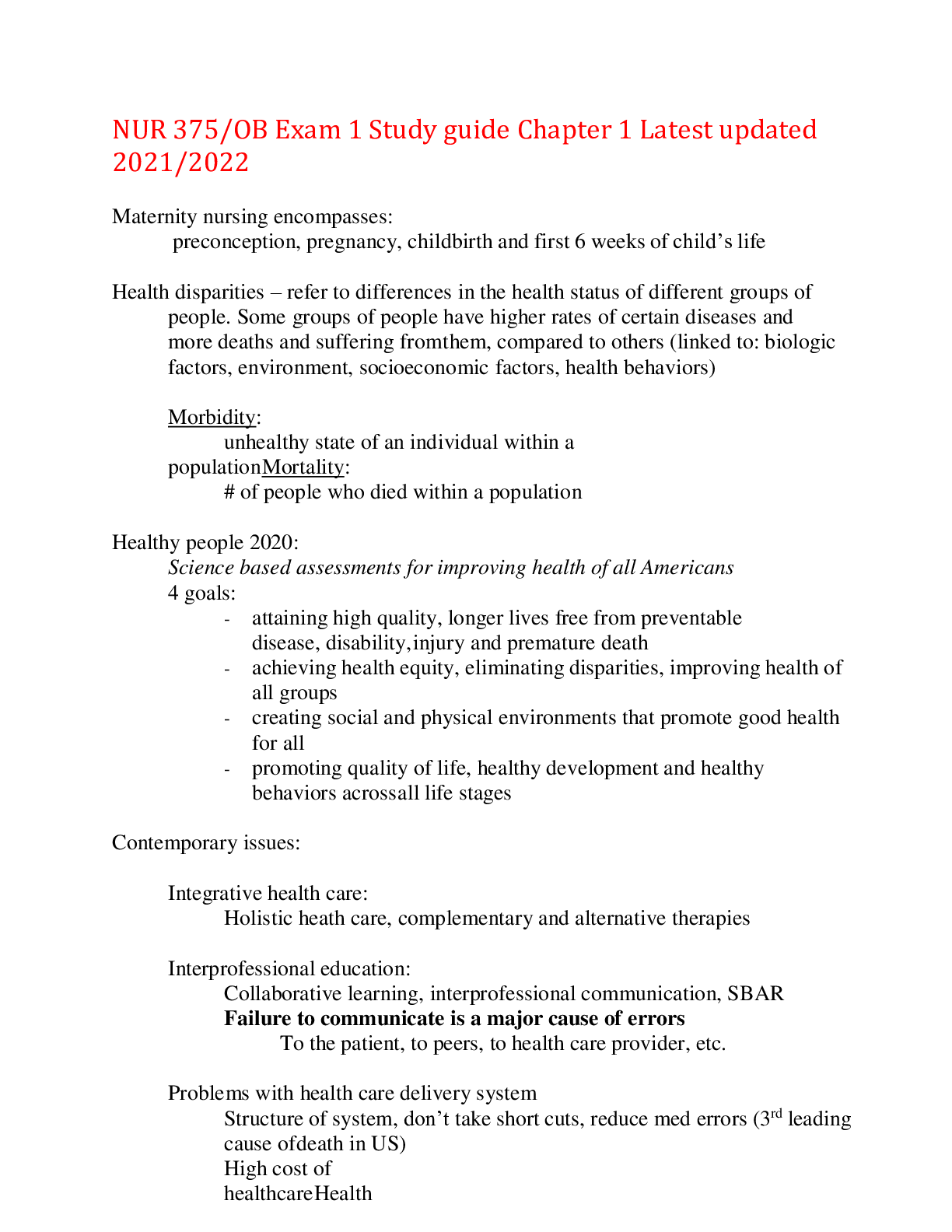
Reviews( 0 )
Document information
Connected school, study & course
About the document
Uploaded On
Mar 26, 2022
Number of pages
31
Written in
Additional information
This document has been written for:
Uploaded
Mar 26, 2022
Downloads
0
Views
38

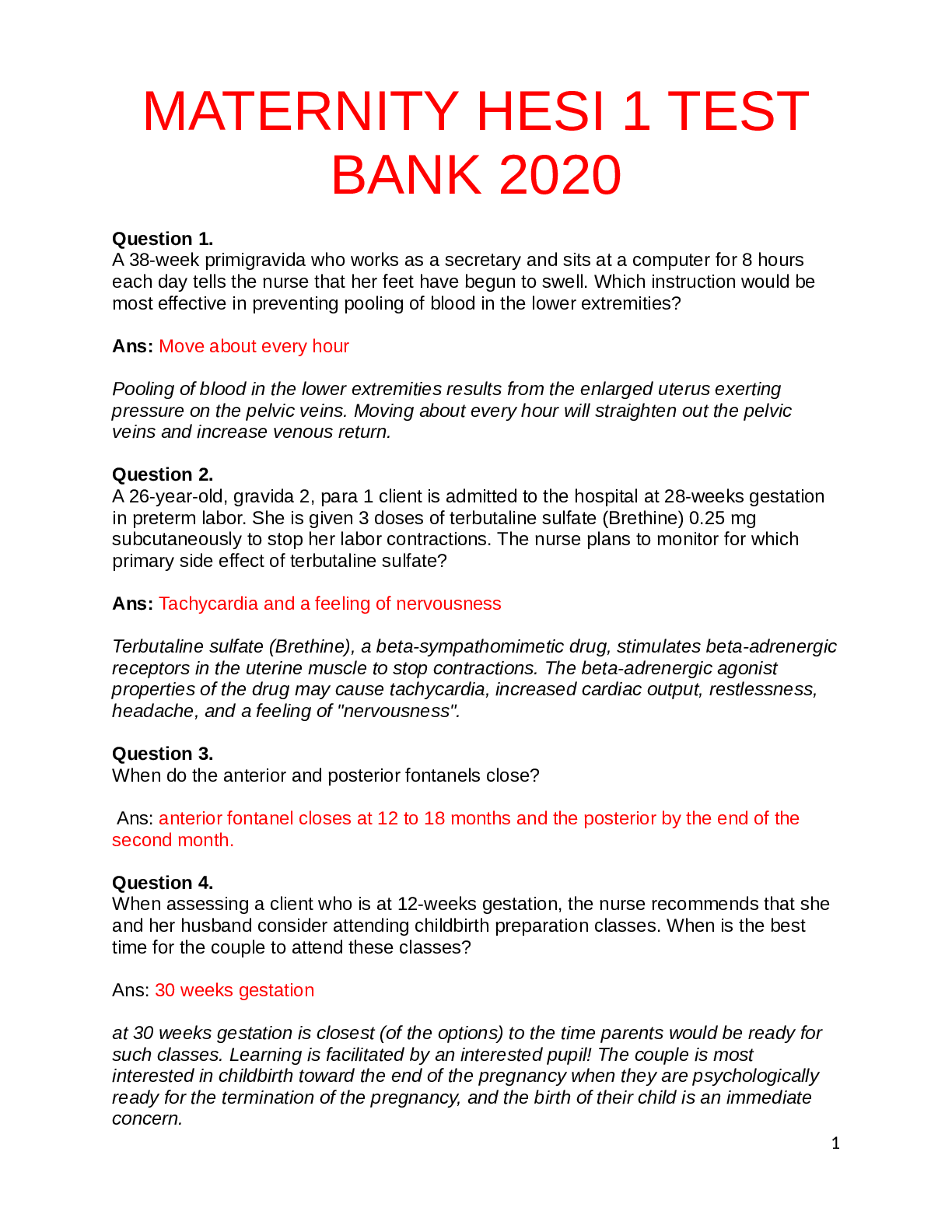
.png)
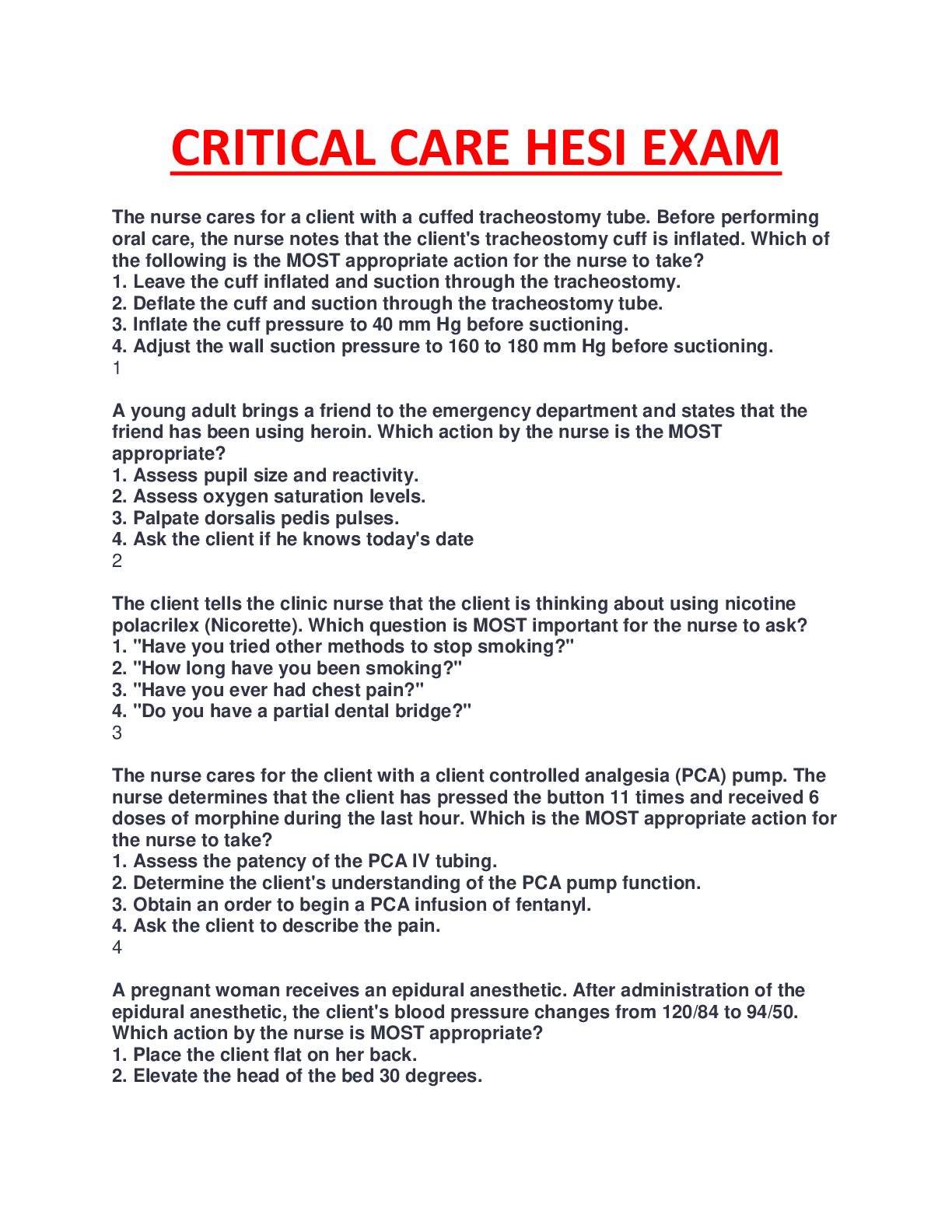
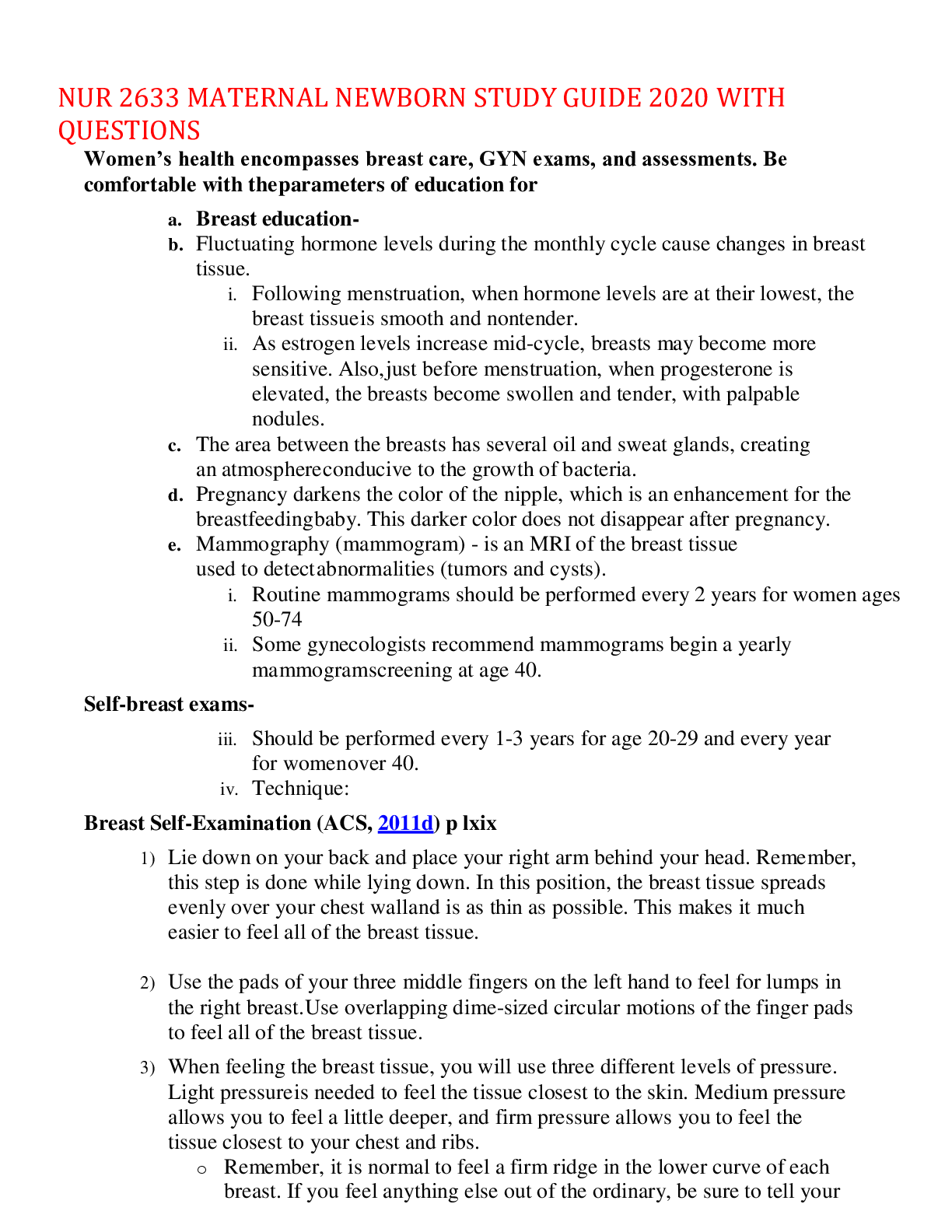
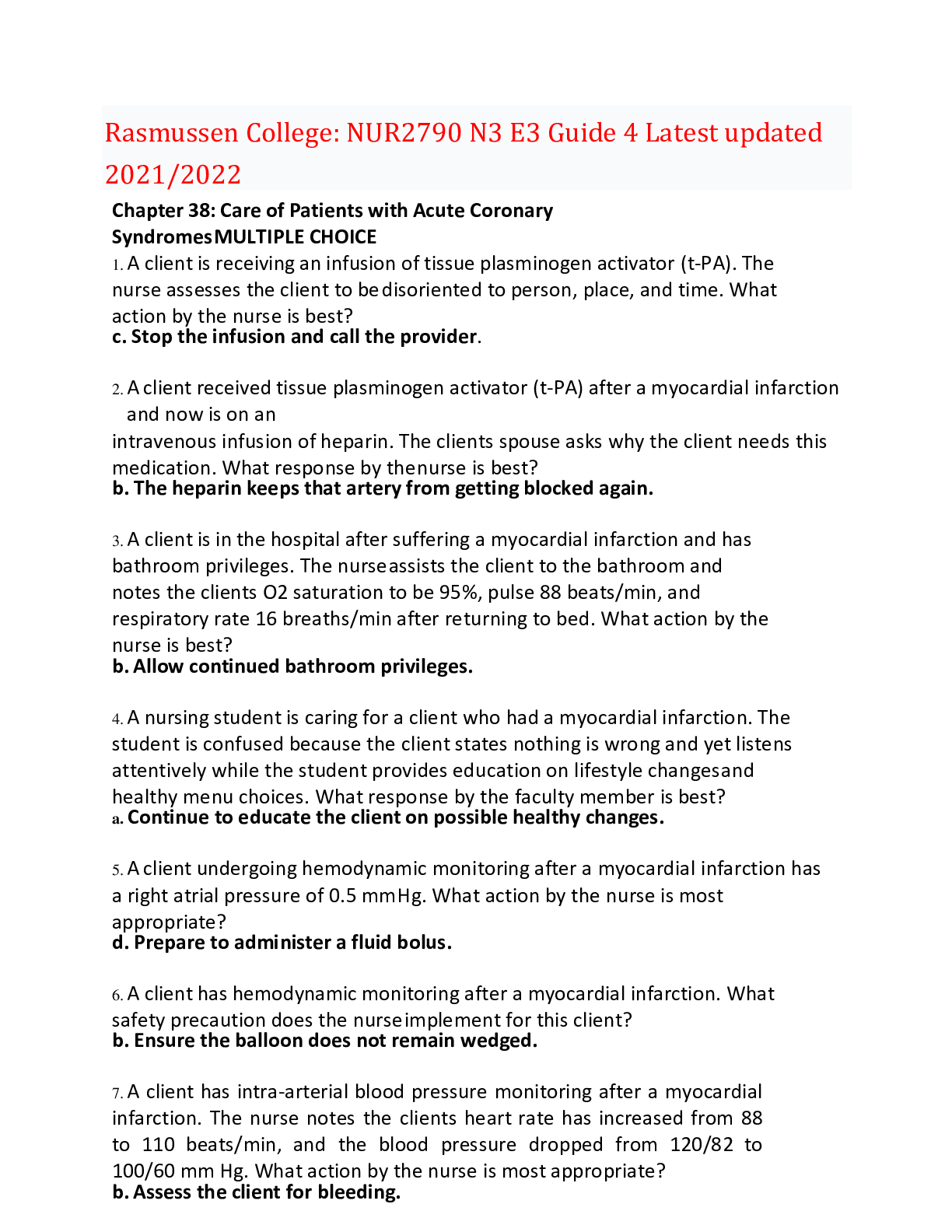

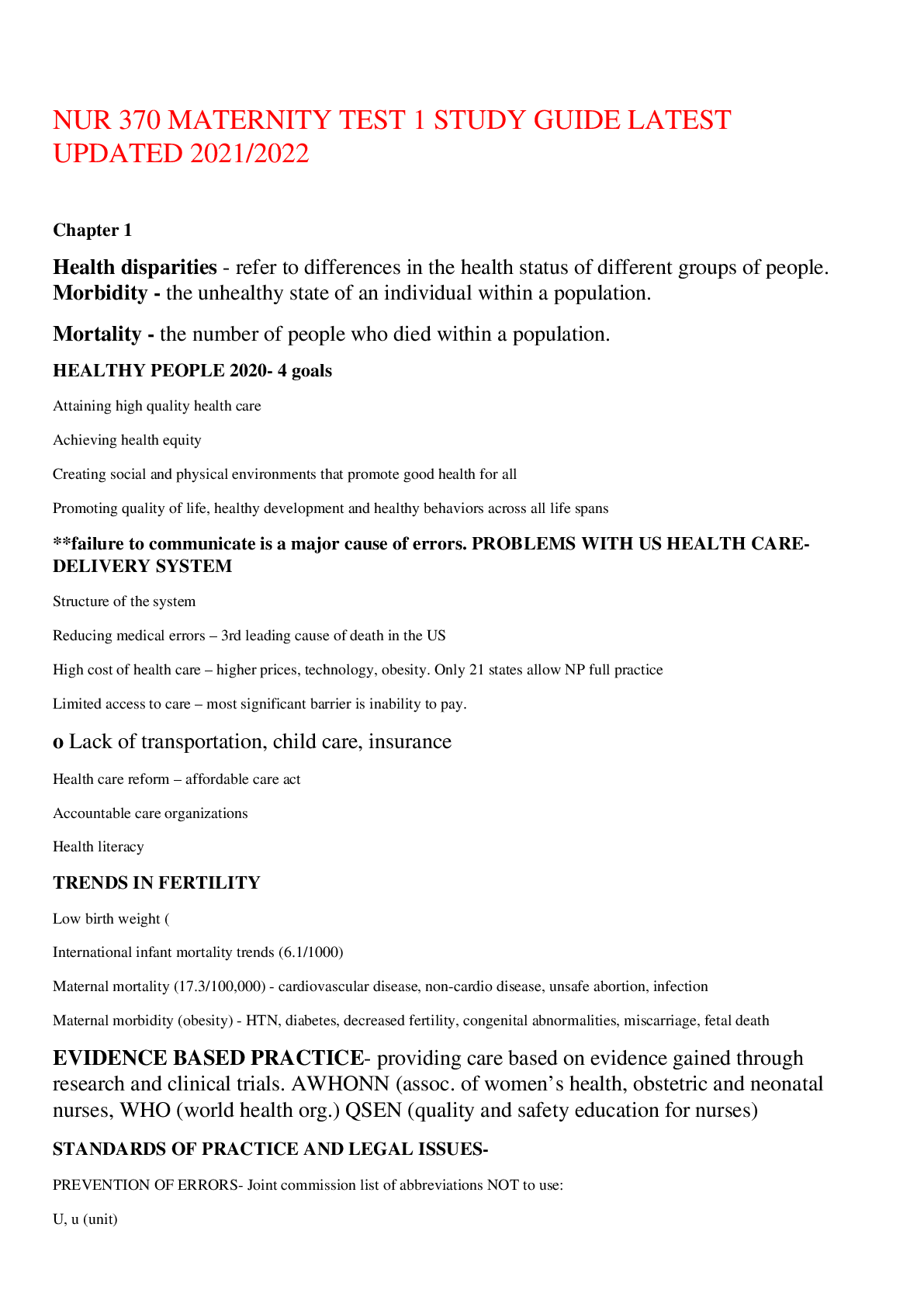
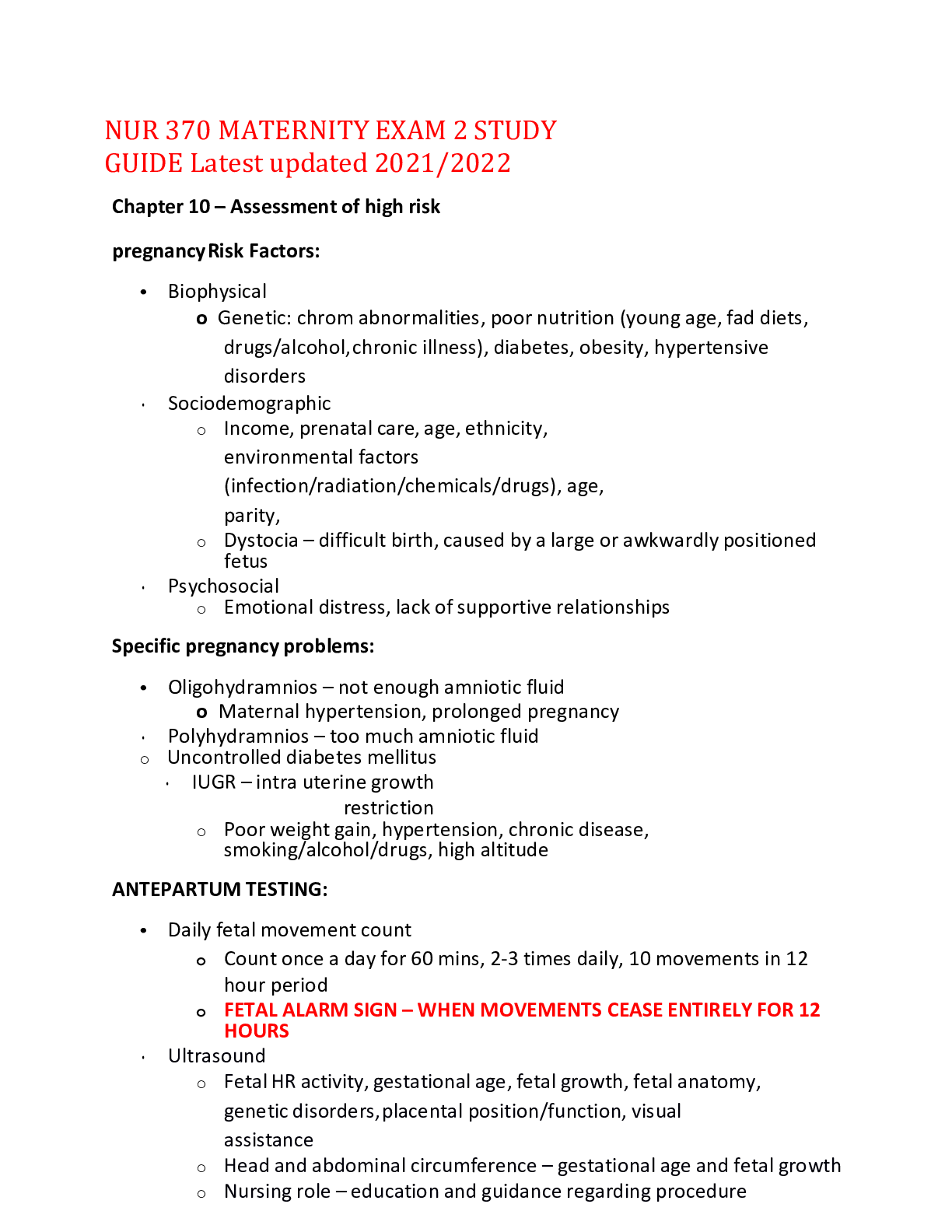
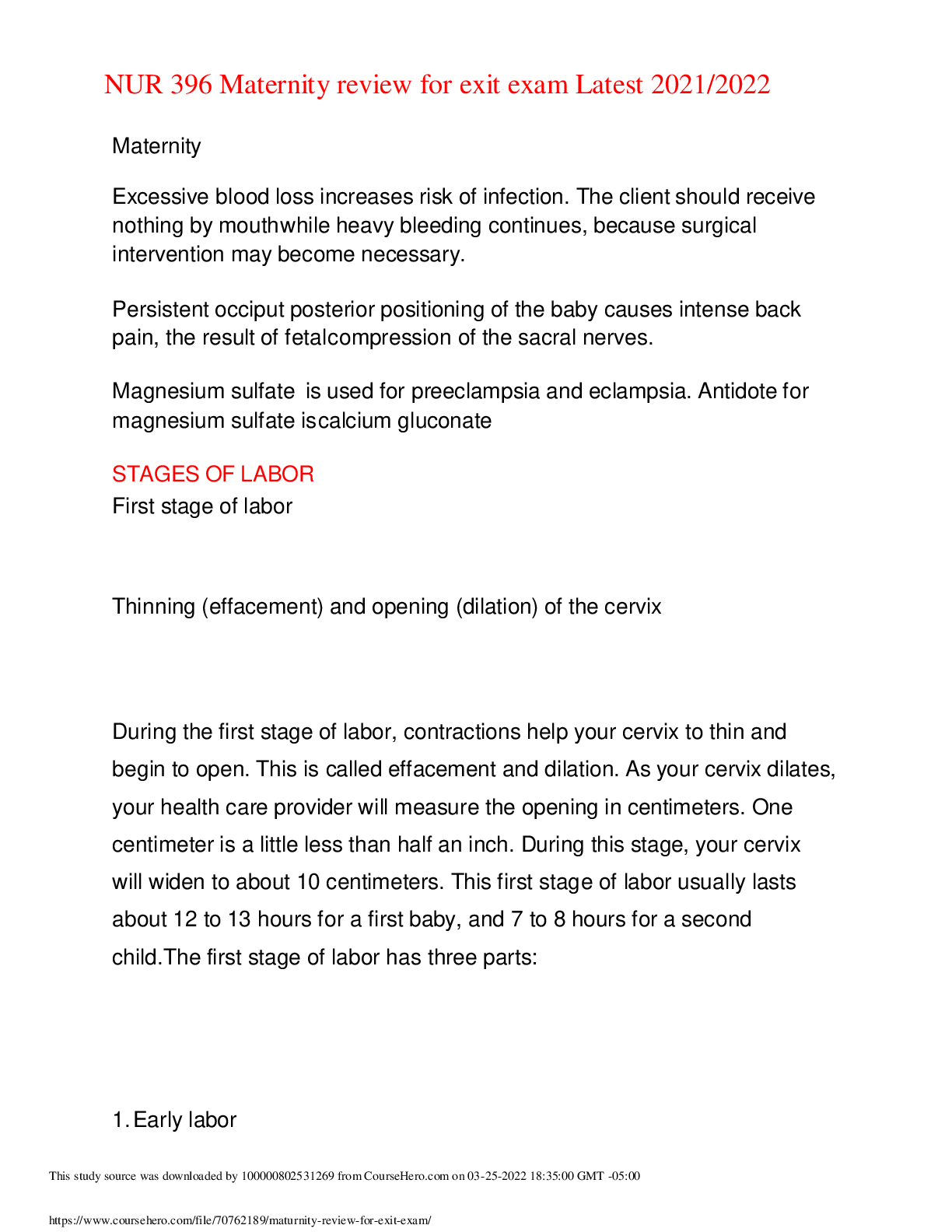
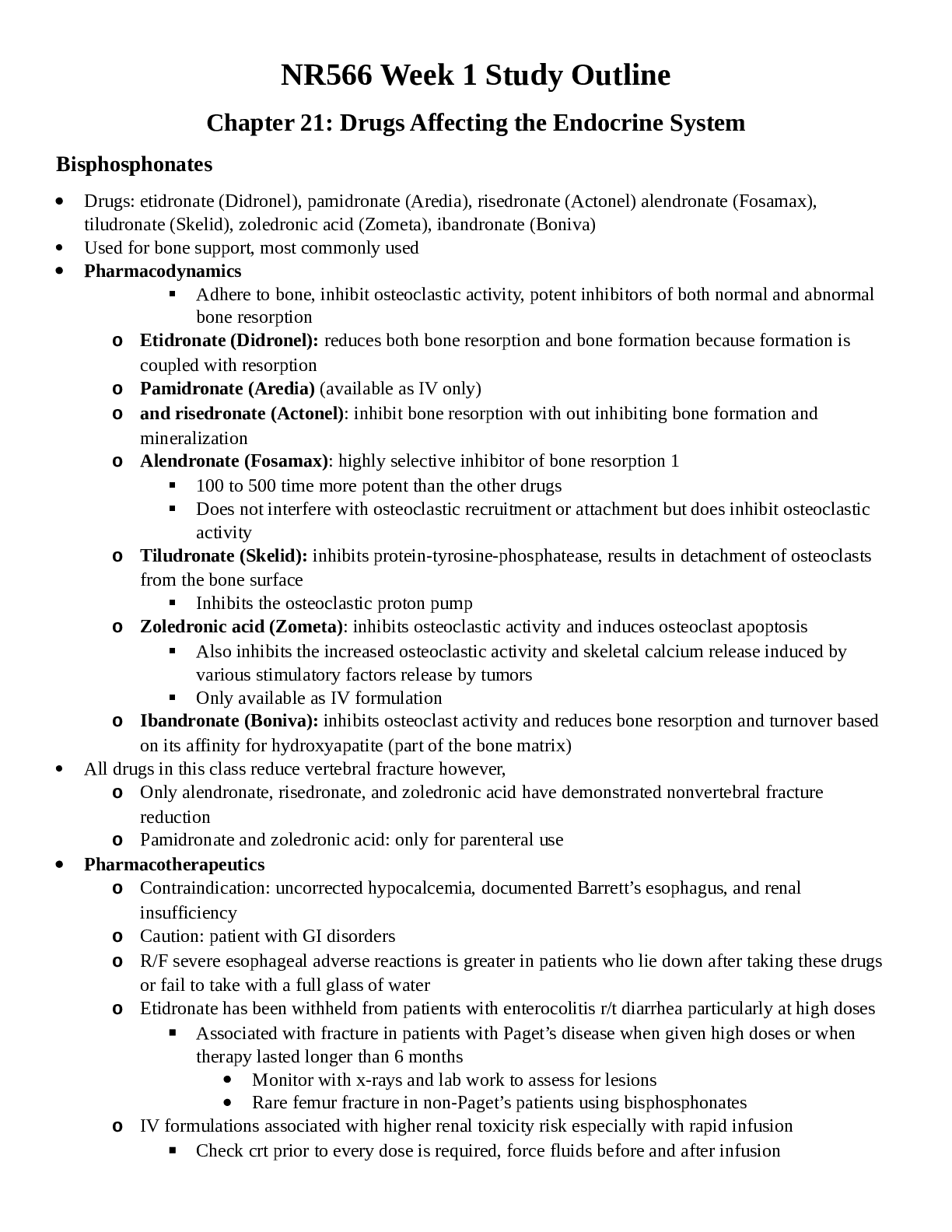
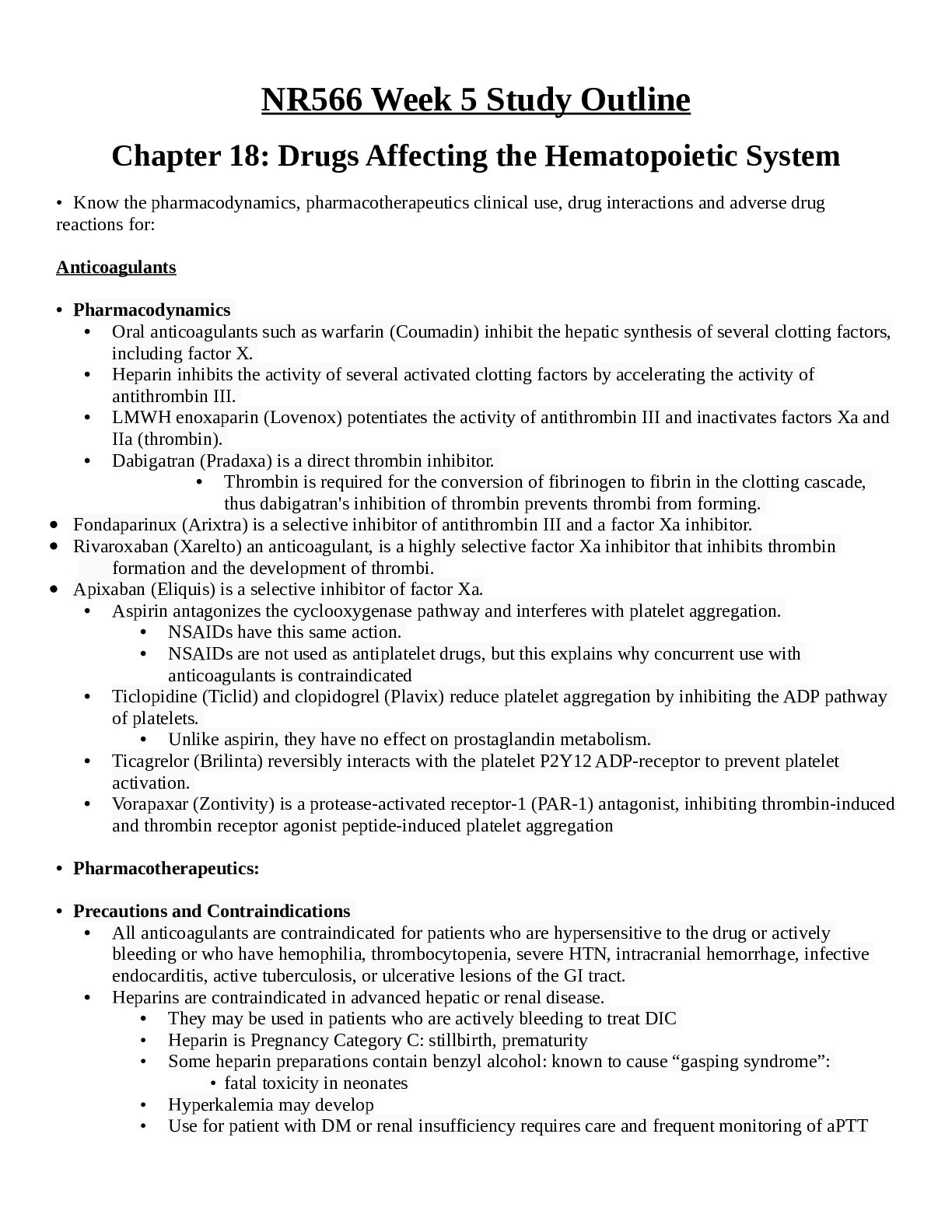
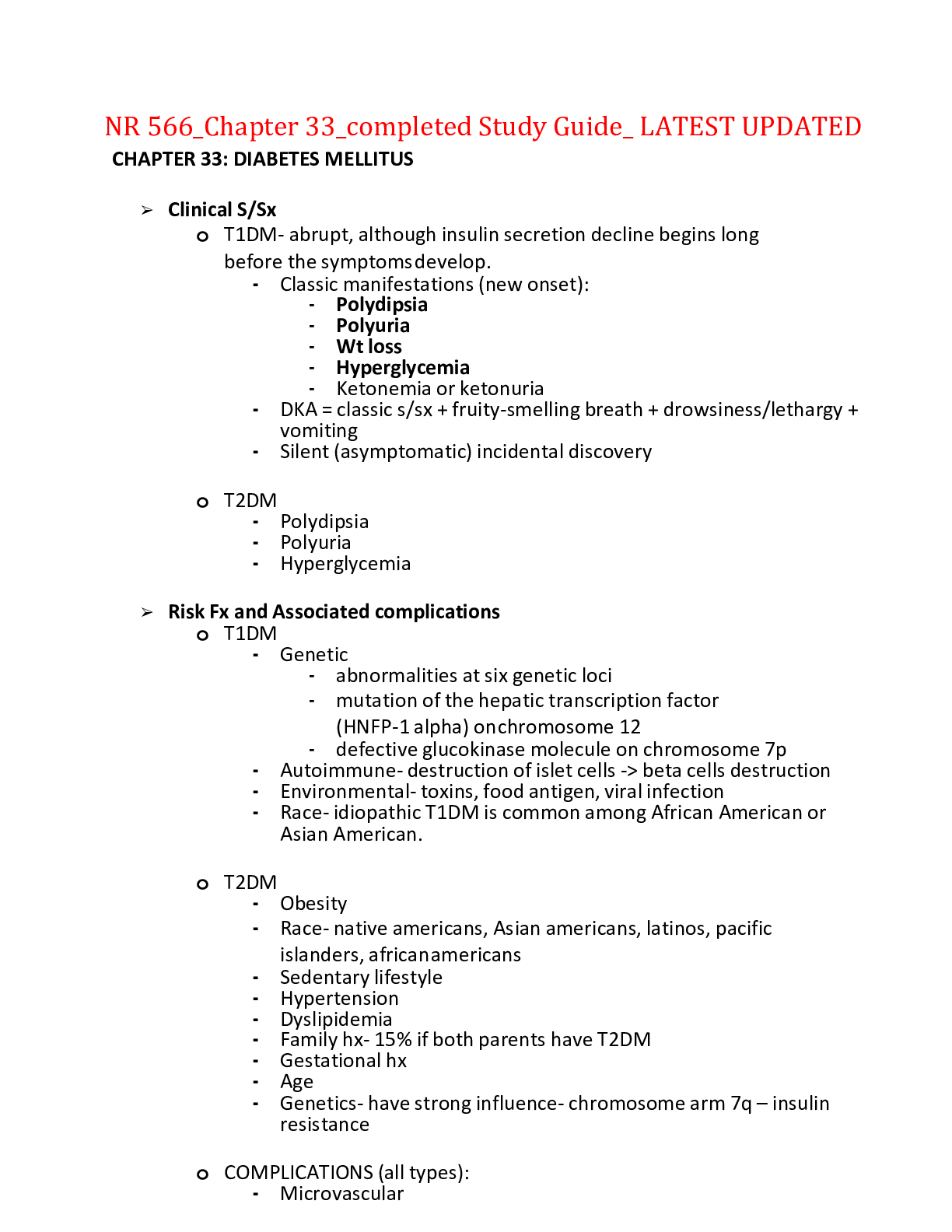
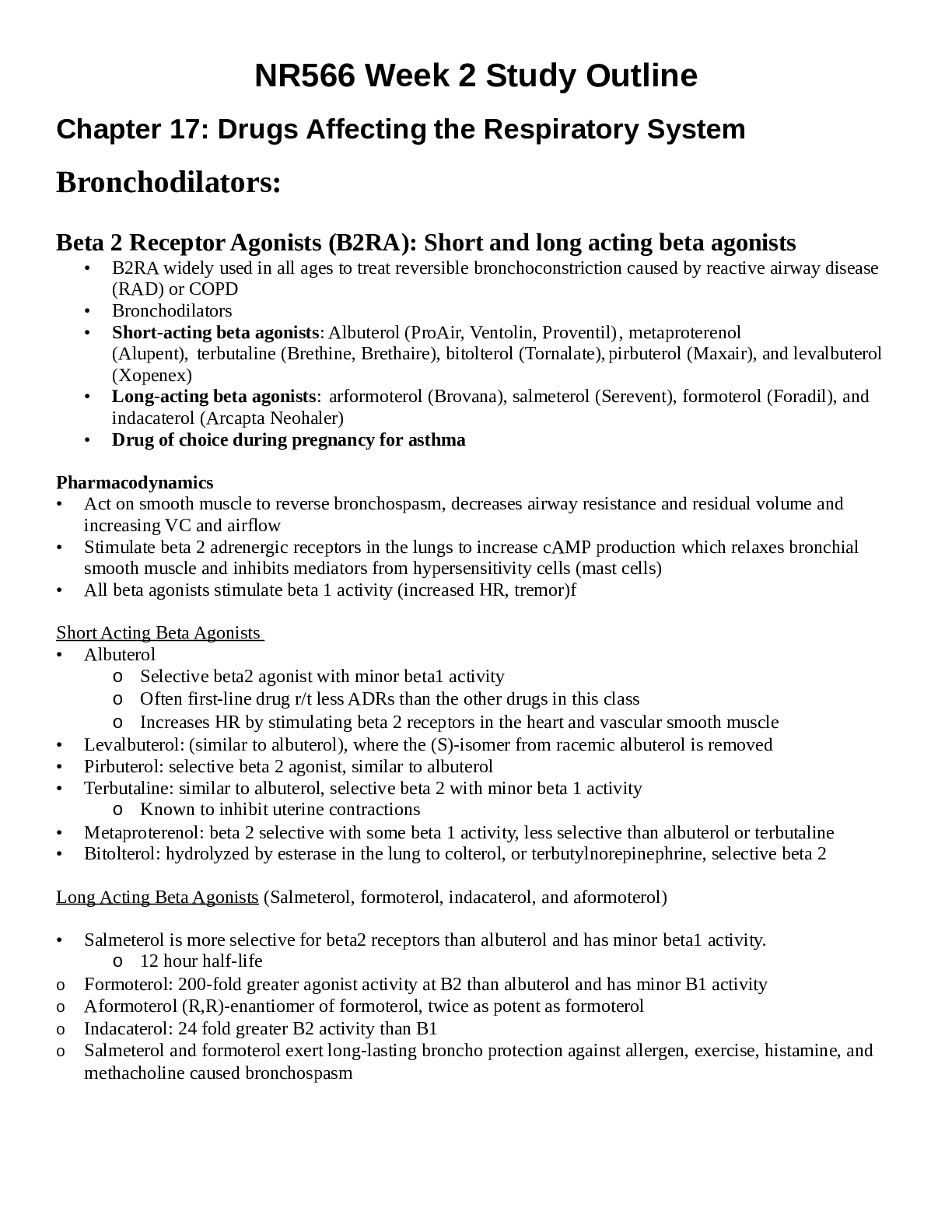
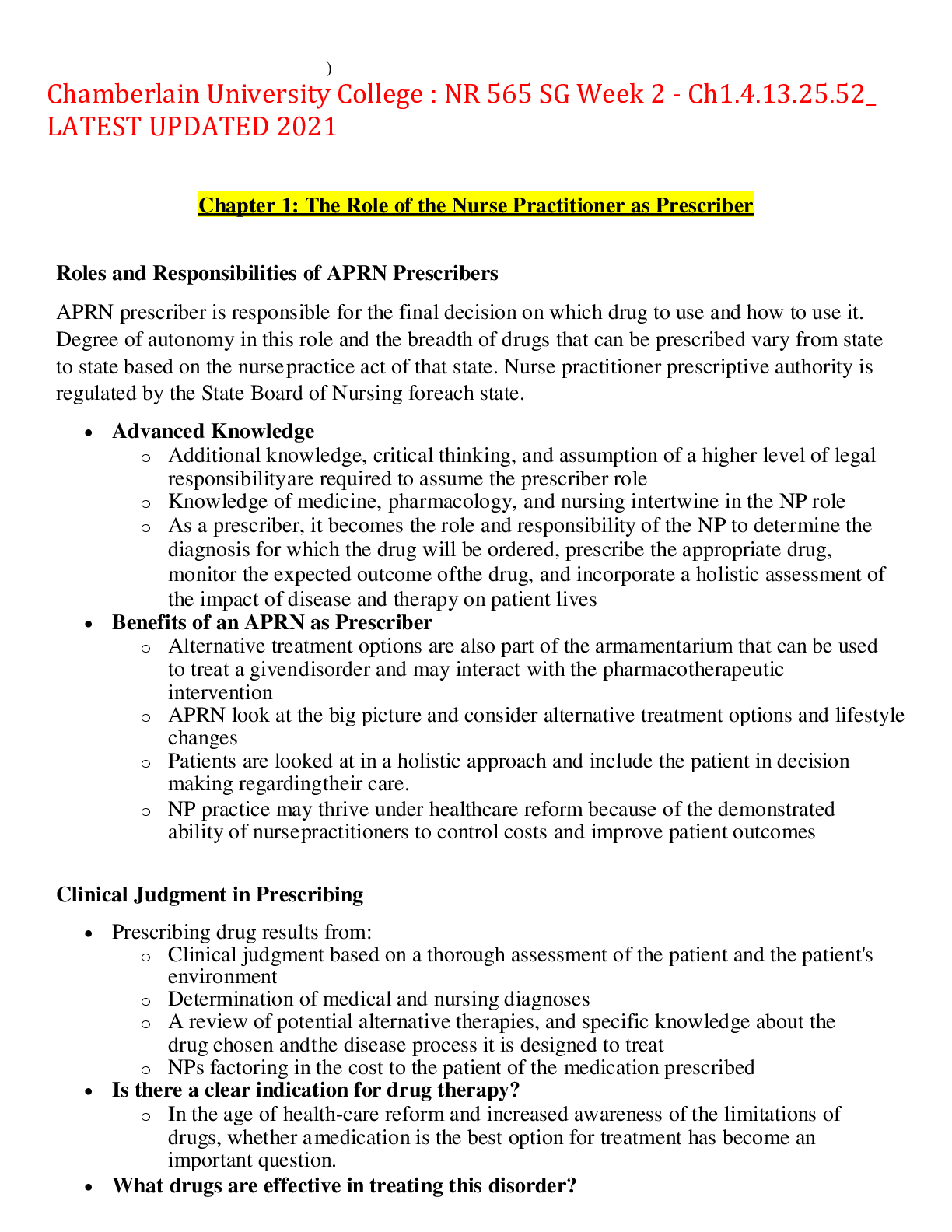

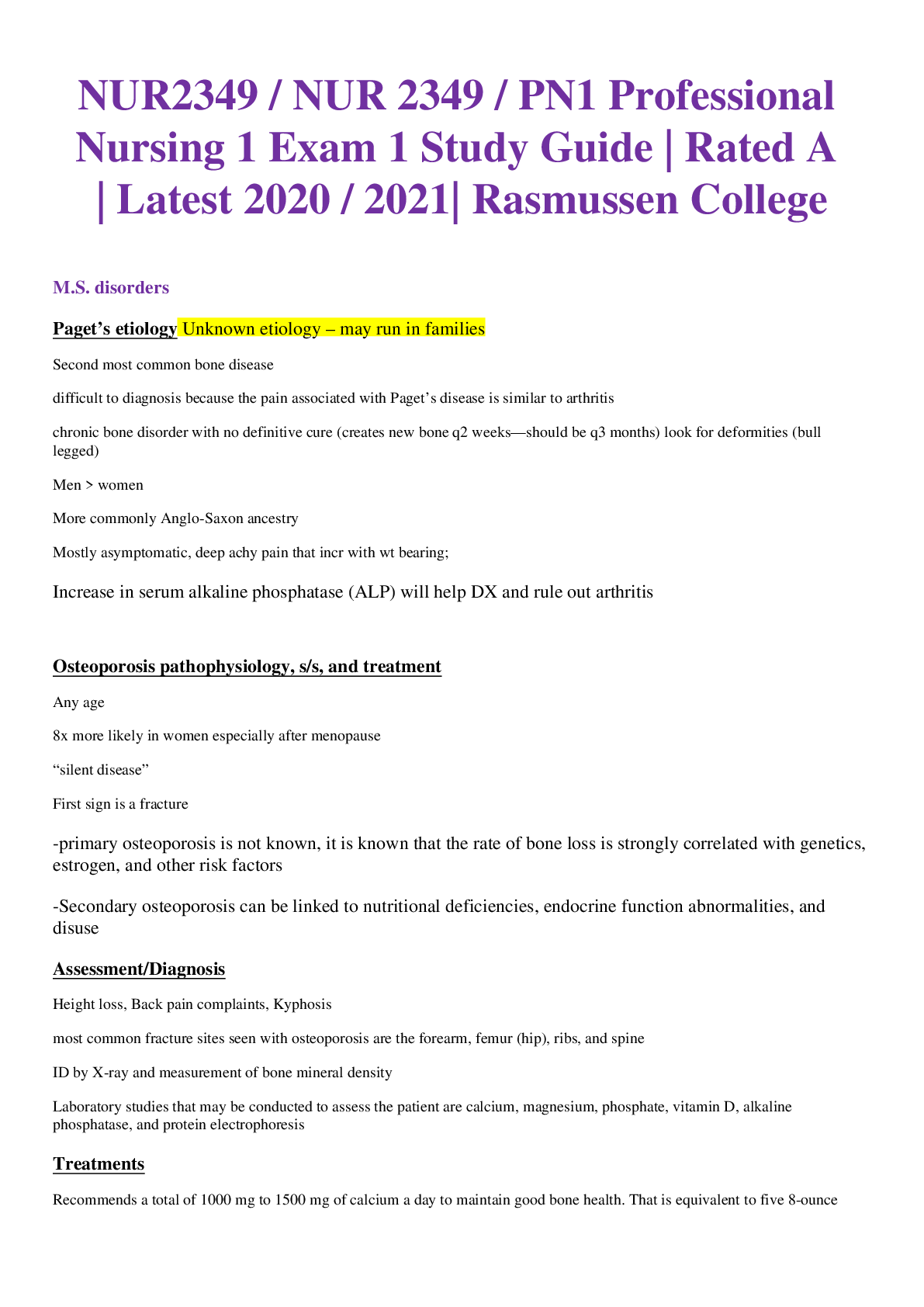
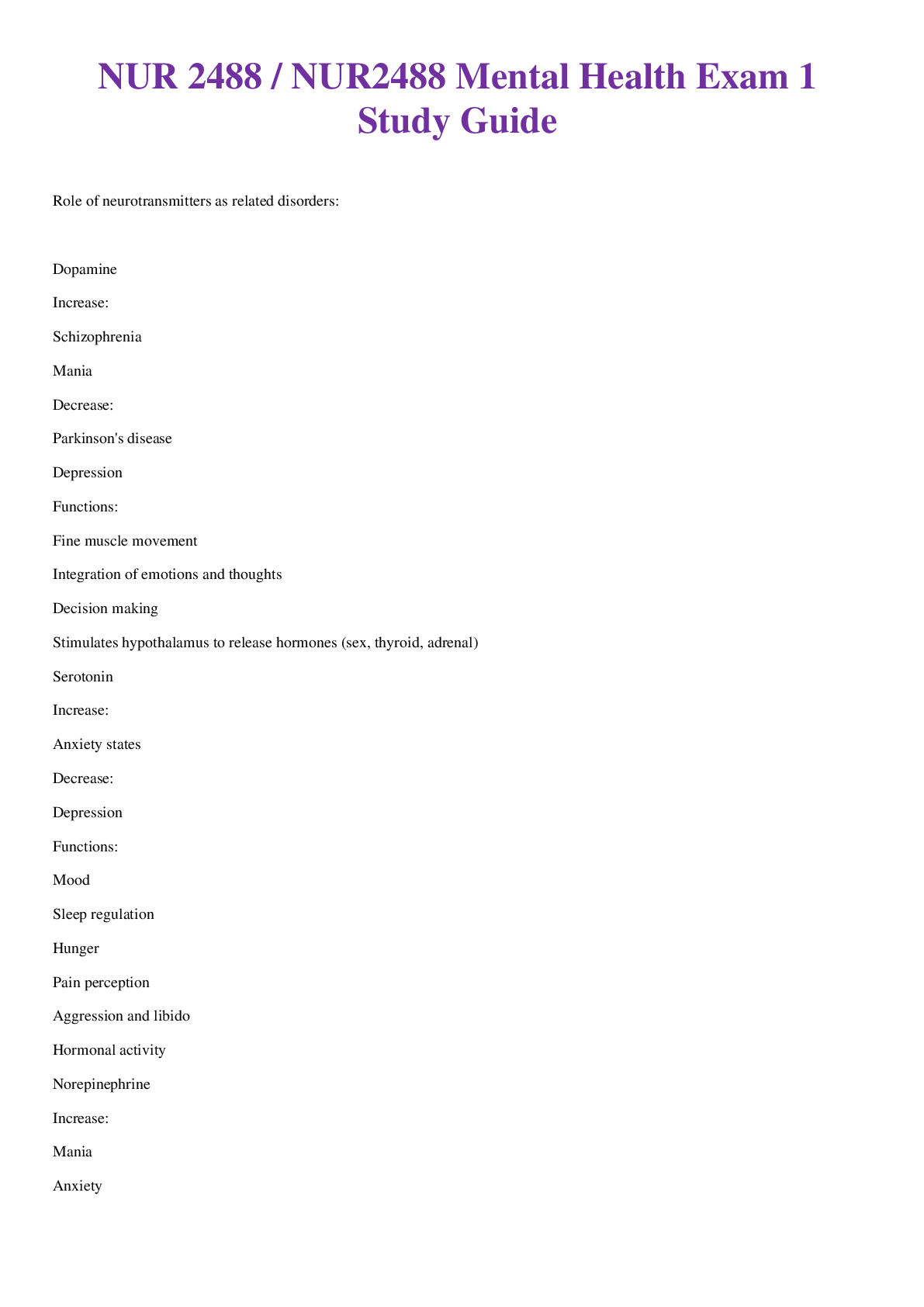
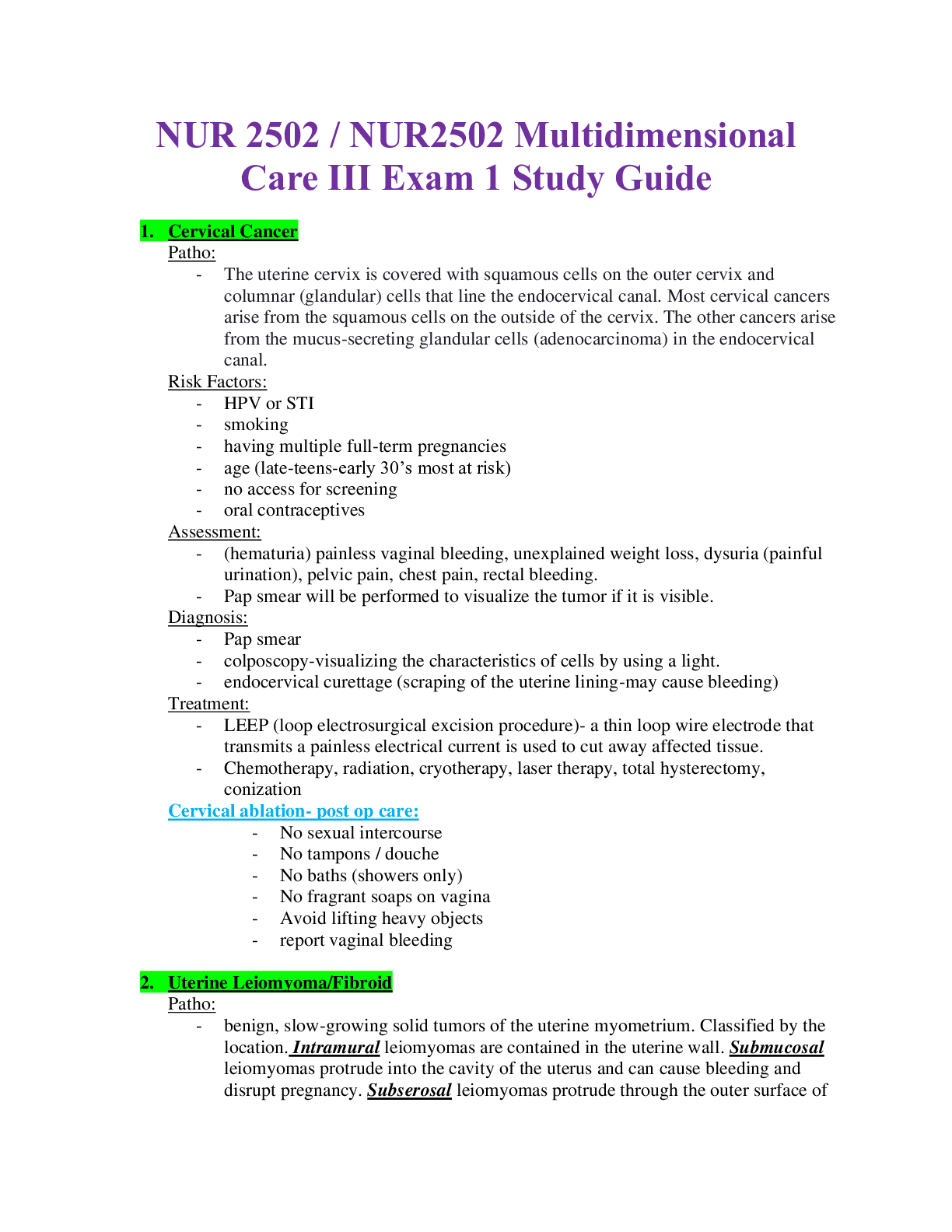

.png)
